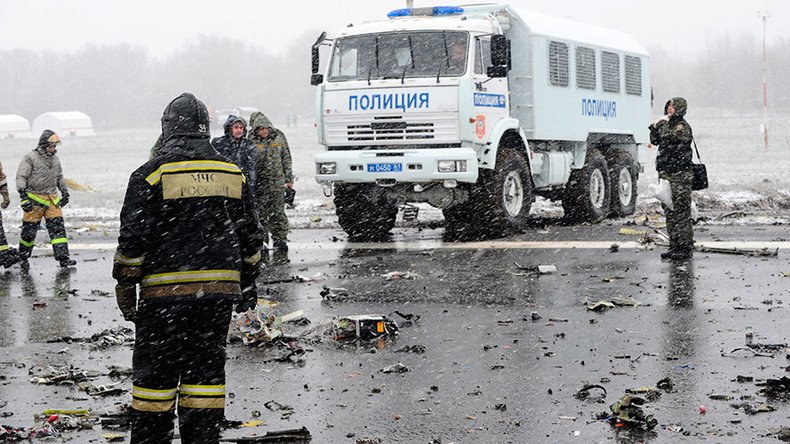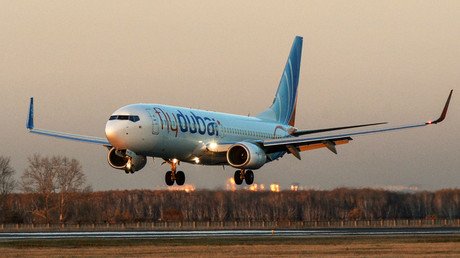‘Flight commander makes final decision to land in bad weather conditions’

A properly trained pilot should be able to land under harsh weather such conditions, Oleg Smirnov, former deputy civil aviation minister of the USSR, told RT.
A Boeing 737 passenger plane belonging to budget carrier Flydubai crashed in Rostov-on-Don in south-west Russia on Saturday morning. Sixty-two people including 6 crew members were killed in the accident.
FIRST VIDEO: Moment #FlyDubai Boeing #FZ981 crashes in Russia killing everyone on board https://t.co/oxOzGehVpvpic.twitter.com/08P6TFXX7r
— RT Play (@rt_play) March 19, 2016
RT: If the first landing attempt fails, is it the pilot or ground control who makes the decision to try a second time?
Oleg Smirnov: All the international rule and regulations assign this right to the commander of the crew. It is his call, it is just the crew commander; he is in charge, he makes the decision.
A properly trained pilot should be able to land under such conditions, and he should be able to land safely.
RT: Another plane trying to land there around the same time decided to divert to another city - why didn't the FlyDubai jet do the same?
OS: Well, it is a good question and it really reveals the extent of professionalism. The crew which made the decision to divert and go to another airfield after analyzing weather conditions at Rostov Airport…
FIRST VIDEO: Moment #FlyDubai Boeing #FZ981 crashes in Russia killing everyone on board https://t.co/oxOzGehVpvpic.twitter.com/08P6TFXX7r
— RT Play (@rt_play) March 19, 2016
RT: As we know so far, there were rain and heavy winds of around 22 m/sec. How dangerous are such conditions for landing a plane?
OS: Exactly, like I was saying, the crew commander, which made this decision acted professionally. And the pilot who made a decision to go for the landing and who failed – this was unprofessional. Of course, strong wind is a problem when landing. But such weather conditions do not absolutely prevent you from landing. A properly trained pilot should be able to land under such conditions, and he should be able to land safely. If he is not confident or if he is not properly trained he has to divert to another airfield.
Another airport 30 minutes away - with better weather
Aviation expert and editor-in-chief for the airlineratings.com website Geoffrey Thomas
RT: The crashed plane spent more than two hours trying to land. What could make the pilots wait for a landing for so long and not head to another airport?
Geoffrey Thomas: After its first approach, which it aborted, it held at 8,000 feet for half an hour, then it held for two more hours at 15,000 feet. It still had another two hours of fuel on board. It had enough fuel for eight and a half hours of flight; when it crashed it had been in the air for six hours. So there was plenty of fuel left to divert. There was an airport only 30 minutes away where the weather was a lot better. That will be one of the questions the investigators will be asking: why on earth not divert because the conditions were very tricky, very strong winds, 70 km/h, strong crosswinds, and this appears to be what caused the aircraft to crash.
When you’ve got very strong crosswinds you can’t use your autopilot
RT: As we know so far, there were rain and heavy winds of around 19 meters per second. How dangerous are such conditions for landing a plane? The plane was only five years old; it must have had the very latest navigational devices.
GT: When you’ve got very strong crosswinds you can’t use your autopilot and you must, if you like, dip your wing into the direction of the crosswind. You also have to yaw the aircraft, as well. We understand the aircraft was actually slightly to the right of the center-line coming in, juggling this very strong crosswind gusting. And then at the last minute the pilots then straighten up and touch down.
Now, we understand that the wing of this aircraft impacted the ground first and then that precipitated the breakup and eventual explosion. It appears early on as if the crosswinds and the handling of those crosswinds may be a major factor in this terrible tragedy.
RT: During the second landing attempt the plane hit the ground - why could that have happened? What could be to blame human error or technical failure?
GT: This is a very interesting situation. I’ve seen the CCTV footage that is almost in conflict with the actual radar data that we have received of exactly what happened with that aircraft. The stall they may be referring to may not be an engine stall, but maybe a wing stall. There is a bit of conflicting information which we’re trying to analyze and come to grips with as to precisely what happened.
The statements, views and opinions expressed in this column are solely those of the author and do not necessarily represent those of RT.













